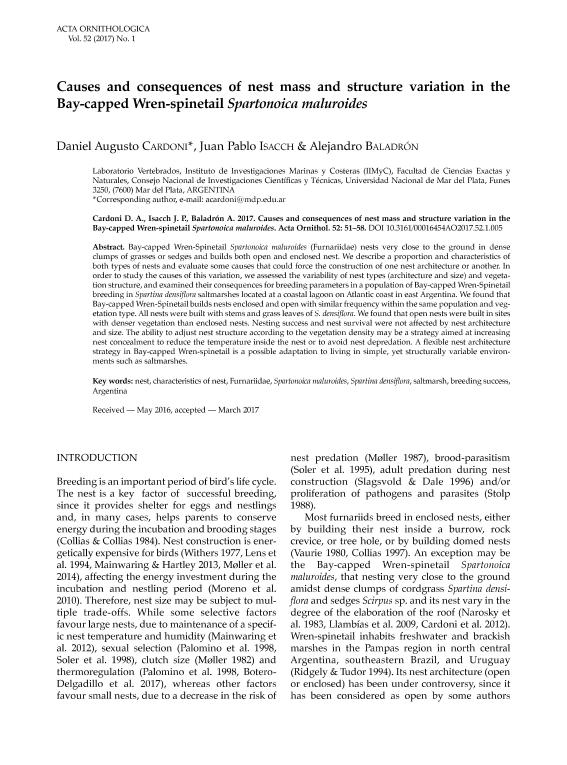Artículo
Causes and consequences of nest mass and structure variation in the Bay-capped Wren-spinetail Spartonoica maluroides
Fecha de publicación:
07/2017
Editorial:
Museum & Inst Zoology
Revista:
Acta Ornithologica
ISSN:
0001-6454
e-ISSN:
1734-8471
Idioma:
Inglés
Tipo de recurso:
Artículo publicado
Clasificación temática:
Resumen
Bay-capped Wren-Spinetail Spartonoica maluroides (Furnariidae) nests very close to the ground in dense clumps of grasses or sedges and builds both open and enclosed nest. We describe a proportion and characteristics of both types of nests and evaluate some causes that could force the construction of one nest architecture or another. In order to study the causes of this variation, we assessed the variability of nest types (architecture and size) and vegetation structure, and examined their consequences for breeding parameters in a population of Bay-capped Wren-Spinetail breeding in Spartina densiflora saltmarshes located at a coastal lagoon on Atlantic coast in east Argentina. We found that Bay-capped Wren-Spinetail builds nests enclosed and open with similar frequency within the same population and vegetation type. All nests were built with stems and grass leaves of S. densiflora. We found that open nests were built in sites with denser vegetation than enclosed nests. Nesting success and nest survival were not affected by nest architecture and size. The ability to adjust nest structure according to the vegetation density may be a strategy aimed at increasing nest concealment to reduce the temperature inside the nest or to avoid nest depredation. A flexible nest architecture strategy in Bay-capped Wren-spinetail is a possible adaptation to living in simple, yet structurally variable environments such as saltmarshes.
Archivos asociados
Licencia
Identificadores
Colecciones
Articulos(IIMYC)
Articulos de INSTITUTO DE INVESTIGACIONES MARINAS Y COSTERAS
Articulos de INSTITUTO DE INVESTIGACIONES MARINAS Y COSTERAS
Citación
Cardoni, Daniel Augusto; Isacch, Juan Pablo; Baladron Felix, Alejandro Victor; Causes and consequences of nest mass and structure variation in the Bay-capped Wren-spinetail Spartonoica maluroides; Museum & Inst Zoology; Acta Ornithologica; 52; 1; 7-2017; 51-58
Compartir
Altmétricas




